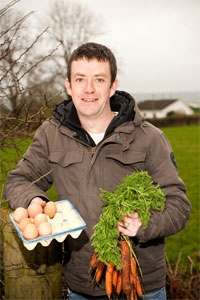Grow it Yourself - February
 As we make the first tentative sowings of 2013, the 2012 growing season, for the moment, keeps on giving. Last weekend I got out in the veg patch in frost and brilliant sunshine to do some jobs which should have been done ages ago, and primary among them was to lift the remaining celeriac and parsnips from the ground.
As we make the first tentative sowings of 2013, the 2012 growing season, for the moment, keeps on giving. Last weekend I got out in the veg patch in frost and brilliant sunshine to do some jobs which should have been done ages ago, and primary among them was to lift the remaining celeriac and parsnips from the ground.
There were only a handful of parsnips – giant mutant roots that have to be hacked to pieces back in the kitchen – so it was a good opportunity to get the bed cleared, forked over and covered in compost.
The celeriac bed was more generous. I harvested about 10 medium size roots which I put in hessian sacks and hung them up in the potting shed. I’ve written here before about how much of a fan of celeriac I am, so at the risk of being repetitive let me say, I will be growing even more celeriac this year. Its storability (is that a word?) makes it, in my eyes, a more practical alternative to celery.
I still have about 20 heads of celery in the ground, and am debating whether just to keep on using them fresh as we need them and risk them rotting, or to lift them, blanch and freeze. In order to get the bed cleared and ready for this year’s growing, I will probably do the latter this weekend.
I also relented and lifted a bed of beetroot that I was sort of hanging on to in hope rather than expectation – these were supposed to be my winter storage beets, but I sowed them too late last year and they didn’t develop properly. I baked them up as baby beets, but noticed that the flavour and texture wasn’t great – the winter in the ground doesn’t seem to have done them any favours.
Apart from potatoes (for which we have to go to the supermarket now), we are managing to keep the hungry gap at bay for the time being. In various locations (either in the ground or in the larder), we still have plenty of carrots, squashes, parsnips, celeriac, onions, garlic, leeks, shallots, spinach, chillpeppers and a small amount of calabrese.
After a slow start, the sowing of oriental greens in the polytunnel that I did back in September is paying dividends too, so we’re having our first tentative salads of the year for lunches.
 Things to Do This Month - February
Things to Do This Month - February
To Do
Turn over the soil only if the weather is dry – if the soil sticks to your boots it’s too early for digging! Keep off the soil to prevent soil compaction - use timber planks to stand on for access. If you have not already done so order/buy your seeds, spuds and onion sets. “Chit” or sprout seed potatoes – put them in a container (e.g. used egg carton or empty seed tray) and leave them in a bright warm place. Check the pH of your soil – you can buy a soil pH testing kit in any garden centre. Lime your soil now if required (to reduce acidity in very acid soils), particularly important in your brassica bed.
Sow
Finally, we can sow some seeds. On a sunny windowsill indoors, in a heated greenhouse or on a heating mat: sow celery, globe artichokes, celeriac, leeks, onions, lettuce, tomatoes, peas, aubergines, peppers/chilli-peppers. In polytunnel or greenhouse: beetroot, Brussels sprouts, summer and autumn cabbage, carrots, leeks, lettuce, radish. Outside: Weather permitting you can try planting out broadbeans, spinach, kohlrabi, onion and shallot sets, Jerusalem artichokes, parsnip and early pea varieties.
Harvest
Winter cabbage and cauliflowers, Brussels sprouts, spinach, kale and leeks.
Recipe of the Month – Celeriac, Potato and Pear Gratin
This is a recipe from Easy Peasy author and chef Sophie Wright. I love the idea of pairing pear with celeriac, and this would make a great accompaniment for Sunday dinner.
Ingredients
• 1 knob butter
• About 400g floury potatoes
• About 400g celeriac
• 2 firm, medium pears (about 300g)
• Salt and freshly ground black pepper
• 400ml double cream
• 100ml whole milk
• 1 clove garlic, peeled and halved
• 1 bay leaf
• 1 good grating nutmeg
Directions:
Heat the oven to 170c. Rub a gratin dish with the butter. Peel the potatoes and slice them thinly, either with a sharp knife or a mandoline. Cut the outer layer off the celeriac and slice this thinly, too.
Peel, quarter and core the pears, and slice each quarter thinly lengthwise. Combine the vegetables and pear in a bowl, season and toss. Arrange the mixture in the gratin dish, pressing it as flat as possible so there are not too many gaps and air pockets.
Put the cream and milk in a saucepan with the garlic halves, the bay leaf, the nutmeg and plenty of salt and pepper, and heat until just below boiling. Pour over the veg in the dish (take the bay leaf out at this stage, but keep the garlic in). Bake for an hour and a quarter to an hour and a half.
The gratin is ready when the top is golden and bubbling, and a small, sharp knife easily pierces the vegetables all the way through.
You may want to turn up the heat to 190-200C (gas mark 5 or 6) for five minutes at the end for a bit of extra bubbling crispness. Leave to rest and cool for five minutes or so before serving.
Tip of the Month – Where and How to Sow Different Seeds
It can be confusing when you read different grower's guides and see that they recommend sowing different vegetables in different ways. For example some seeds should be sown in seed trays, while others can be sown direct in the soil. Why is this? The answer is generally either (1) some seeds are large and/or reliable and will do quite well in the soil in your garden or (2) some vegetables don't mind the root disturbance which happens when you transplant, while others will die at the very mention of the phrase.
Cabbages, cauliflowers and celery for example, transplant very well - you can therefore sow them quite liberally in a seed tray (one without modules) and then ‘prick them out’ in to module trays later on. These vegetables therefore have three growing stages - the first in the seed tray, then in the module tray and finally outside in their final growing position.
Cucumbers, squashes and pumpkins hate root disturbance - they must always be sown in pots. When they outgrow the pot they are sown in, they can be transplanted carefully later in to a large one. At that stage they should be sturdy enough not to be distressed by the move. Here’s a rough, but not exhaustive guide, to how to sow the different veg. In some cases it comes down to personal preference – for e.g. I sow beetroot in module trays, but I know some people like to sow them direct.
Sow in Pots: Cucumbers, squash, pumpkin, courgette
Sow in Modules: Beetroot, kohlrabi, lettuce, spinach, tomatoes, pepper
Sown in Trays for Pricking out: cabbage, cauliflower, celery and celeriac
Sow Direct Outside: carrots, parsnips, peas, beans, garlic, onion (sets)
------------------------------------
Get Involved
 GIY aims to create a healthier, more sustainable world where people grow their own food. We bring people together in community groups and online to share tips and knowledge. We also run events and programmes to inspire and support people to grow their own. GIY is a registered charity (CHY 18920) and proudly supported by Woodies DIY. Support our work by becoming a member of GIY for €35 and receive a member’s pack with seed selection, member’s card, GROW magazine, grower’s guides and more.
GIY aims to create a healthier, more sustainable world where people grow their own food. We bring people together in community groups and online to share tips and knowledge. We also run events and programmes to inspire and support people to grow their own. GIY is a registered charity (CHY 18920) and proudly supported by Woodies DIY. Support our work by becoming a member of GIY for €35 and receive a member’s pack with seed selection, member’s card, GROW magazine, grower’s guides and more.
For more tips, information and support visit www.giyireland.com
Michael Kelly is a freelance journalist, author and founder of GIY Ireland.
© GIY Ireland 2012 – all rights reserved.






There are currently no comments
Leave a comment
Not a member? Register for your free membership now!
Or leave a comment by logging in with: